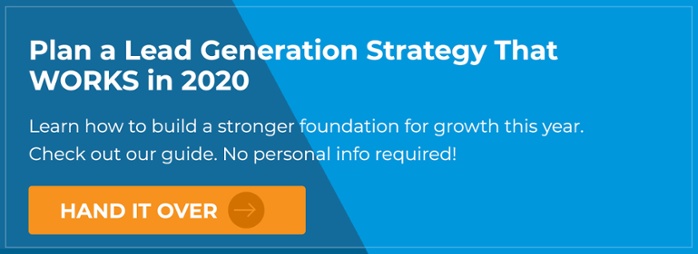
Inbound Marketing vs. Outbound Marketing
Patrick Dodge
Founder
People who work on inbound marketing sometimes forget that our bosses and clients often don’t understand what it truly means, and how it compares with outbound marketing.
Even after explaining the difference, you’ll likely face some questions:
Which one will help us generate more leads?
Do we need both?
How do the costs compare?
These are good questions that I’m going to weigh in on. First, let’s start with definitions.
What is Inbound Marketing?
Inbound marketing is nothing new.
It’s been around since the dawn of commerce, although it didn’t have a cool, catchy name until about ten years ago.
Driven by the explosive growth of online content and the impact it’s had on the way people make buying decisions, inbound marketing is about attracting people to your brand by sharing valuable information.

Unlike traditional forms of marketing, inbound doesn’t rely on the brand pushing messages out to various demographics in hopes of getting a bite. Instead, brands create content that helps a buyer persona solve problems or complete tasks, while also guiding them along their journey to making a purchase.
Today, most brands are using some form of content strategy to generate leads. B2B businesses are keenly aware that customers don’t rely on advertising or salespeople to decide what to buy. They do their own research, and rarely contact a salesperson until their decision is nearly made.
An inbound marketing campaign can help people find your brand in their moment of need, when they are looking for quality information that will help them get something done.
Helping people is the name of the game now. It builds trust, boosts credibility, and increases sales.
Inbound marketing encompasses multiple digital marketing components, including search engine optimization (SEO), social media, blogging and/or video, chatbots, and email marketing.
What is Outbound Marketing?
Outbound marketing, on the other hand, is where the brand stays in the driver’s seat, initiating contact with the customer with an offer of some kind.
This is most often accomplished through traditional advertising channels – like television, radio, or direct mail – or through outreach from a salesperson, like cold calling.
Outbound marketing doesn't necessarily mean interrupting people with an unwanted message, at least not anymore. Account based marketing is an example of outbound selling using inbound principles. In these cases, the brand identifies specific people within a company, and creates a campaign targeted only at them.
Even though this is clearly “interruptive selling,” the account-based marketer warms the first interaction by personalizing the message to address specific pains he or she has identified in the prospect.
Some channels and tactics straddle the line between outbound and inbound. For example, Google AdWords is an advertising platform that uses sales offers, but it’s driven by search engine queries. Even though it’s advertising, a user has to search for the product or service before the ad presents itself.
Likewise, social media advertising shares inbound and outbound characteristics. Most people think of social media as a delivery channel for content (more closely related to inbound marketing), but it depends on “push marketing” methodology that’s more closely aligned with outbound practices.
Different Strategies. Different Results.
Ever since inbound became everyone’s favorite buzzword, outbound marketing has gotten in a bad rap.
Spend two minutes on LinkedIn and you will see a ton of posts all preaching the same thing: Cold calling is dead. Outbound selling is dead. Everything about marketing is dead that doesn't involve creating content that helps potential customers.
This is bunk, of course.
Inbound is vital to generating leads and acquiring customers, but it has downsides as well.
The biggest differences are that inbound takes longer to deliver results – it can take months of consistent effort before ROI appears on the horizon. But that effort has a bigger pay off in the long term.
If you invest years into well strategized campaign, producing new content every week, you can attract qualified traffic to your website for years to come. Inbound marketing has a compounding effect, meaning the more content you produce – assuming that the content is quality and well targeted at your buyer persona – your results will increase at an increasing rate as your content arsenal gets bigger and bigger.
Outbound marketing, on the other hand, offers more instant gratification. The instant you turn an ad campaign on, leads can start flowing into your website. There is still plenty of optimization and management that needs to be done, as you strive to boost your results at a lower cost-per-acquisition, but results should arrive quickly.
I once heard someone compare the two approaches like this: Inbound marketing is planting an apple tree so you get fruit every year. Outbound marketing is like running to the store and buying a bag of apples. Once you stop paying for the ads, the stream of leads runs dry.
How do the Costs Compare?
As you probably expected, there is no hard and fast rule when it comes to cost.
Your company’s investment will depend on the budget, revenue goals, and the resources available in-house.
Here are just a few of the services involved in an inbound campaign:
- Buyer Persona Research
- Content Strategy & Mapping
- Keyword & Topic Research
- Content Creation – blogging, video production, whitepapers, and other offers
- Conversion Path Development
- Social Media Marketing
- Email Marketing & Lead Nurturing
- Sales Enablement & Lead Scoring
Most businesses don’t have all the people, experience, and expertise to effectively manage all of these pieces in-house, so they hire an agency to supplement their efforts. The average cost for a full plate of agency services is around $70,000 a year (including a marketing automation platform to work on),and can range as high as $156,000 or more.
Outbound costs depend on the ad channels you use, how aggressive your campaign is, and the number of business development people you have making dials. Let’s not forget that outbound also includes direct outreach through cold calls and email (or “warm calls” if you are using a personalized approach that makes helping the prospect the first priority and selling them the second).
There’s no clear answer as to which approach is more efficient, but if your organization cannot invest in experienced professionals to manage your inbound campaign, I would not go down this path.
We’ve seen too many businesses cut corners and end up discouraged by the results. If you can’t do it right, don’t do it.
Inbound and Outbound Marketing: Why You Need Both
Businesses that see the best results incorporate both inbound and outbound tactics in their strategies.
While inbound is certainly attractive to most businesses – who wouldn’t want new prospects to come find them, rather than vice versa? – the competition has gotten so intense in some industries that it’s almost impossible for a newcomer to rise above the noise without a very good content amplification strategy.
I’m not making a case against inbound. It’s what we do at Creative Side. We believe it’s the future of marketing and can produce amazing results when managed correctly, but every industry is different. Some require less effort to rise above the noise, while others need a little more creativity to turbo-charge your content.
Outbound tactics can accelerate your results with inbound, particularly when it comes to content distribution, one of the most challenging components of a strategy.
Paid promotion is increasingly necessary on social media channels, especially Facebook. Advertising on Google AdWords can enhance your rankings on search engines, complementing your SEO. Last but not least, your sales people should continue prospecting and establishing relationships with “warm calling.”
Contrary to what some people say on LinkedIn, cold calling is not dead. The only thing that’s dead is the old, spammy way of doing it. By reaching out to a prospect with a personalized message that shows you know a thing or two about their business and offering a tip that helps them solve a problem – you can build relationships.
Inbound and outbound are not exclusive anymore. Most businesses need elements of both to create the impact they are looking for. The hard part is finding the balance that will help you close the gap you’ve identified in your goal setting. The rest is fun.
Apr 20, 2018 9:14:07 AM
